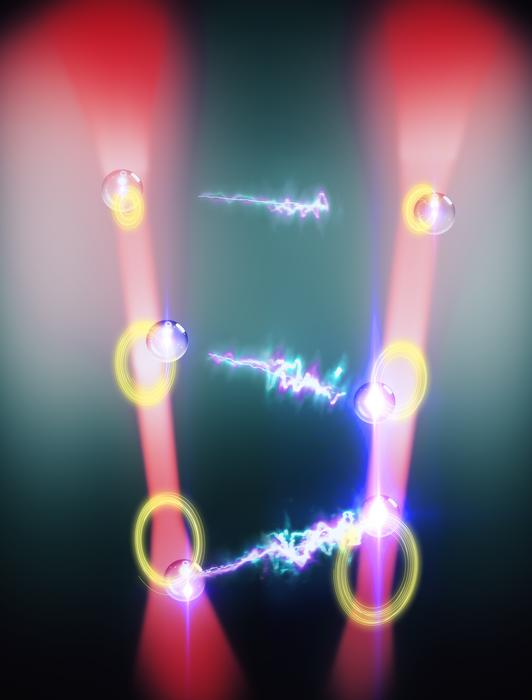Using two optically trapped glass nanoparticles, researchers observed a novel collective Non-Hermitian and nonlinear dynamic driven by nonreciprocal interactions. This contribution expands traditional optical levitation with tweezer arrays by incorporating the so called non-conservative interactions. Their findings, supported by an analytical model developed by collaborators from Ulm University and the University of Duisburg-Essen, were recently published in Nature Physics.

Credit: Equinox Graphics
Using two optically trapped glass nanoparticles, researchers observed a novel collective Non-Hermitian and nonlinear dynamic driven by nonreciprocal interactions. This contribution expands traditional optical levitation with tweezer arrays by incorporating the so called non-conservative interactions. Their findings, supported by an analytical model developed by collaborators from Ulm University and the University of Duisburg-Essen, were recently published in Nature Physics.
Fundamental forces like gravity and electromagnetism are reciprocal, meaning two objects either attract or repel each other. However, for some more complex interactions arising in nature, this symmetry is broken and some form of nonreciprocity exists. For example, the interaction between a predator and a prey is inherently nonreciprocal as the predator wants to catch (is attracted to) the prey and the latter wants to escape (is repelled).
Non-Hermitian dynamics describe similar nonreciprocal systems in quantum mechanics by incorporating dissipation, gain, and non-conservative interactions. These dynamics are observed in photonic, atomic, electrical, and optomechanical platforms and hold potential for sensing applications and exploring open quantum systems. Now, a University of Vienna team has made the first concrete steps in this direction by observing nonlinear and Non-Hermitian dynamics with nonreciprocally coupled nanoparticles.
Tabletop & Glass
Led by Uroš Delić of the Vienna Center for Quantum Science and Technology (VCQ), the researchers developed a tabletop experiment where two glass nanoparticles oscillate in distinct optical tweezers, interacting as if one were a predator and the other a prey. Optical tweezers, a technique pioneered by 2018 Nobel Laureate Arthur Ashkin, isolate particle motion from the environment and make the system highly tunable. Previous experiments showed that closely spaced particles scatter the tweezer light toward each other, leading to interferences creating optical forces, which can be nonreciprocal.
In this study, the researchers tuned the laser beam phases and the distance between the particles in order to control the interactions. “What I like most about this is that we control the physical model with a computer, as simple as programming a computer game”, says Manuel Reisenbauer, the PhD researcher in the team. As a result, they produced constructive interference around one particle and destructive interference around the other. This created a positive feedback loop resembling a chase-runaway dynamic. “A small displacement of one particle forces the other into motion, which in turn exerts an even stronger force,” explains Uroš Delić, lead author of the paper.
The team described the particles’ motion in their respective tweezers without interaction as analogous to a swing. When anti-reciprocal interactions were applied, the “swings” began to follow each other, breaking parity-time reversal symmetry. The simplest way to see it is simply to play the “film” backward: using the predator-prey analogy, the particles appear to reverse roles.
Amplified Amplitude
The positive feedback loop from anti-reciprocal interaction also amplified the swing amplitudes of both particles. When the interaction became stronger than the friction, the particles swung continuously, maintaining a constant oscillation amplitude, demonstrating nonlinear dynamics. “This system is special because it features nonreciprocal and nonlinear forces, similar to many natural examples,” says Benjamin Stickler from Ulm University, the lead theorist on the work. “The dynamics resulted in a limit cycle phase, where particle motions resemble swings rotating fully around the top beam while still following each other.” The limit cycle solution is a general concept found in many disciplines, including laser physics, drawing analogies between nanomechanical motion and laser dynamics.
“We were impressed by the good agreement between the theoretical model and experimental data,” says Uroš Delić. “This suggests our system is ideal for observing even richer collective nonreciprocal dynamics when trapping larger ensembles of beads.” The authors believe nonreciprocal forces will have numerous applications in force and torque sensing. Additionally, combining these results with methods for bringing trapped bead motion to the quantum regime could open new research into nonreciprocally interacting quantum few-body systems.
Journal
Nature Physics
DOI
10.1038/s41567-024-02589-8
Article Title
Non-Hermitian dynamics and non-reciprocity of optically coupled nanoparticles
Article Publication Date
25-Jul-2024




